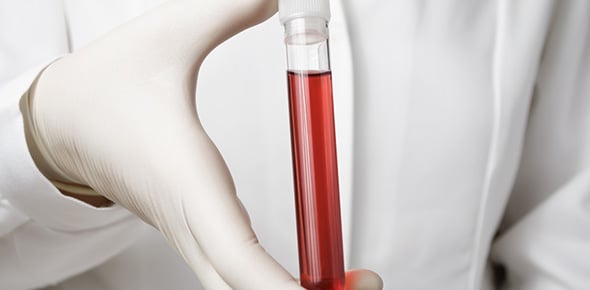Blood Transport Through The Heart

Short cloze activity of sections 9.1 - 9.2 from your text book 'Science Quest 2 - 3rd edtn. 'This will be marked and the marks will go towards your overall for the unit.
Questions and Answers
- 1.
The most common blood group is
Explanation
The most common blood group is O+. This blood group is considered the most common because it is the most prevalent in the population. The positive sign indicates the presence of the Rh factor, which is another antigen found on the surface of red blood cells. The combination of O and Rh+ makes O+ the most common blood type worldwide. The variations in capitalization (O and o) and the addition of spaces (+ and +) do not affect the overall blood type classification.Rate this question:
- 2.
...carries blood away from your heart under high pressure.
Explanation
Arteries are blood vessels that carry oxygenated blood away from the heart to various parts of the body. They have thick, elastic walls that can withstand the high pressure generated by the heart's pumping action. Arteries branch out into smaller vessels called arterioles, which further divide into tiny capillaries to deliver oxygen and nutrients to the body's tissues. Therefore, the correct answer is artery/arteries.Rate this question:
- 3.
...carry blood to the heart.
Explanation
Veins are blood vessels that carry blood back to the heart. They have thin walls and contain valves that prevent blood from flowing backward. Veins are responsible for transporting deoxygenated blood from the body tissues back to the heart, where it can be reoxygenated. The plural form of vein is veins.Rate this question:
- 4.
...are the smallest blood vessels.
Explanation
Capillaries are the smallest blood vessels in the body. They are responsible for the exchange of oxygen, nutrients, and waste products between the blood and the surrounding tissues. Capillaries have thin walls that allow for easy diffusion of substances. They connect the arterioles and venules, forming a network throughout the body. The correct spelling is "capillaries," and the variations "capillary," "capilary," and "capilaries" are incorrect.Rate this question:
- 5.
There is a pigment containing iron in the red blood cells called...
Explanation
Haemoglobin is a pigment found in red blood cells that contains iron. It is responsible for carrying oxygen from the lungs to the rest of the body and transporting carbon dioxide from the body tissues back to the lungs. Haemoglobin gives red blood cells their characteristic red color and plays a crucial role in the oxygenation of tissues and organs.Rate this question:
- 6.
...blood cells help us to fight infections by eating bacteria and other foreign matter.
Explanation
White blood cells, also known as leukocytes, play a crucial role in our immune system. They help us fight infections by engulfing and destroying bacteria and other foreign matter. These cells are able to recognize and target pathogens, releasing enzymes and chemicals to neutralize them. The process of engulfing and digesting foreign particles is called phagocytosis. The correct answer, "white," refers to white blood cells, as they are responsible for protecting our body against infections and maintaining overall health.Rate this question:
- 7.
...is pumped in to the heart, and ... is pumped out.
Explanation
Separate both words with a comma
for example: red, whiteRate this question:
- 8.
...in the heart to prevent the blood from flowing backwards, keeping it in one direction.
Explanation
The correct answer is "valves,valve" because valves are structures found in the heart that prevent the blood from flowing backwards. They ensure that blood flows in one direction, allowing for efficient circulation throughout the body.Rate this question:
- 9.
The human heart beats ... times a minute.
Explanation
The human heart beats at a rate of 60-100 times per minute. This range is considered normal for a healthy adult. The heart beats to pump blood throughout the body, supplying oxygen and nutrients to the organs and tissues. The heart rate can vary depending on factors such as age, physical activity, stress levels, and overall health. Regular exercise and a balanced lifestyle can help maintain a healthy heart rate within this range.Rate this question:
- 10.
The heart has ... chambers.
Explanation
The heart is a muscular organ that pumps blood throughout the body. It is divided into four chambers: two atria and two ventricles. The atria receive blood from the body and lungs, while the ventricles pump blood out to the rest of the body. This four-chambered structure allows for efficient circulation of oxygenated and deoxygenated blood, ensuring that the body's tissues receive the necessary oxygen and nutrients.Rate this question:
- 11.
A person who has iron deficiency may become ...
Explanation
Iron deficiency can lead to a condition called anemia, which is characterized by a decrease in the number of red blood cells or a decrease in the amount of hemoglobin in the blood. Hemoglobin is responsible for carrying oxygen to the body's tissues, so when there is a deficiency in iron, the body is unable to produce enough healthy red blood cells. This can result in symptoms such as fatigue, weakness, shortness of breath, and pale skin, which are all characteristic of anemia. Therefore, the correct answer is "anaemic."Rate this question:
Quiz Review Timeline +
Our quizzes are rigorously reviewed, monitored and continuously updated by our expert board to maintain accuracy, relevance, and timeliness.
-
Current Version
-
Mar 22, 2023Quiz Edited by
ProProfs Editorial Team -
Oct 14, 2009Quiz Created by
Sibel87
 Back to top
Back to top


